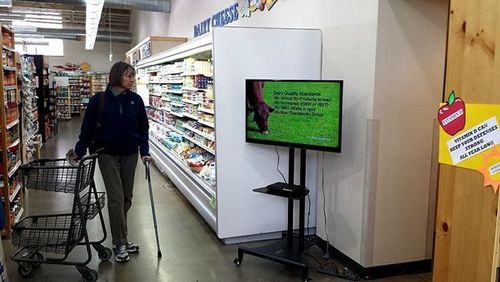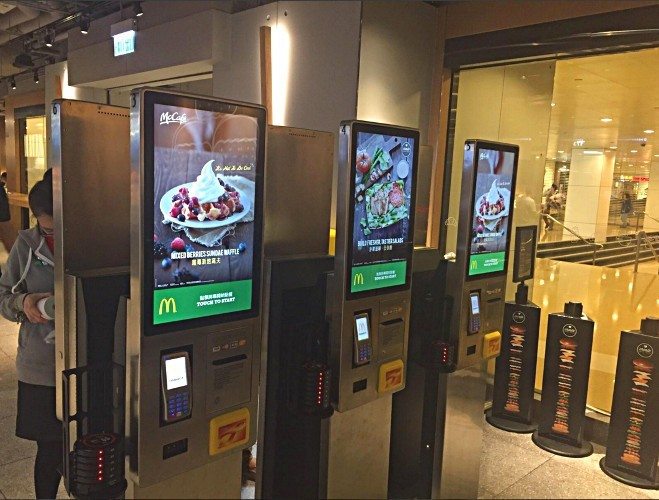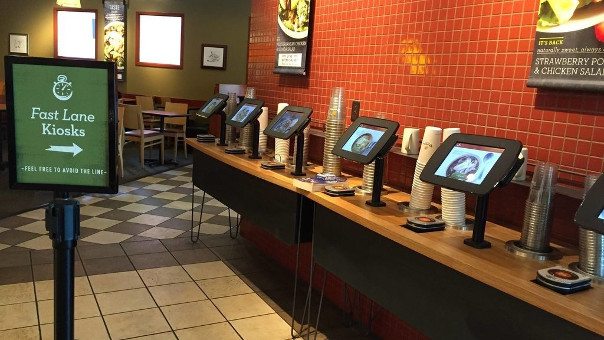TapSnap is excited to be unveiling its new Photo Marketing Kiosks at the Nightclub & Bar Convention & Trade Show in Las Vegas from March 31 to April 1.
Source: www.nightclub.com
TapSnap is excited to be unveiling its new Photo Marketing Kiosks at the Nightclub & Bar Convention & Trade Show in Las Vegas from March 31 to April 1.
Source: www.nightclub.com
Hewlett-Packard Co. said it would sell its Snapfish photo-sharing site toDistrict Photo, part of the computer maker’s plan to refocus operations as it splits in two.
Source: www.bloomberg.com
Snapfish works with retailers to help consumers store, share and print photos online. District Photo, which is based in Beltsville, Maryland, handles digital printing for business and other customers. Terms of the deal, which was announced Tuesday, weren’t disclosed.
Our social media photo kiosk is a easy and interactive brand ambassador! Give your visitors a fun easy way to interact with your brand and drive awareness!
Source: www.pacificdigitalsigns.com
Photo social media kiosk photo station company iSnap was awarded a patent for its software and technology.
Source: www.bizjournals.com
social media kiosks
Retail Stores Set to Account for 51% of the Total Market Share
Source: www.prnewswire.com
The latest report from India research mills covers Photo Kiosks. The market for photos has certainly grown and is growing. The means to merchandise them to the general public from retail locations has taken on new ways though.
Android/iOS: No one wants to have to call a locksmith. If you get locked out of your house, or just want to order some easy copies, KeyMe allows you to create duplicate keys that are either mailed to you, or cut at local kiosks.
Source: lifehacker.com
Editor Note: Nice note on LinkedIn on using countertop kiosks for outside ordering during COVID-19 shelter time. The example below is from Habit Burger who is using countertop kiosks from Olea Kiosks.
at The Habit Burger Grill is a genius! Because he chose to deploy our Austin model kiosks he was able to move them outside during business hours for customers to place orders safely outside. (His idea) They even placed some hand sanitizer off to the side because it’s super easy to sanitize a finger. Mike called us earlier today and asked us to share what The Habit has done in order to show others in the industry. While not business as usual it does help for the new temporary normal. Great job Mike! Our customers rock. Hopefully more can do the same.

Published by NRA April 2020 — Advice include relying on your automated ordered systems in order to maintain social distancing.
The purpose of guidance is just that, to offer you direction and provide a framework for best practices as you reopen.
But as the saying goes, the devil is in the details, and not every restaurant is the same and not every opening scenario will align. We recognize that not everyone has access to guidance, and that is where the National Restaurant Association can provide help.
Make sure your person-in-charge has an up-to-date ServSafe Food Manager certification. The Food and Drug Administration requires every facility to have a person in charge on-site during open hours and also directs that the person in charge should have a food manager certification.
Provide ServSafe food handler training for your workers. They’re your front line; educating them protects them, you and your guests.
Make technology your friend. Contactless payment systems, automated ordering systems, mobile ordering apps, website updates and simple texts can help you to communicate and conduct business with reduced need for close contact. As you begin to reopen, keep communicating with customers (your hours, menu items, reservations, etc.), and help promote your social distancing and safety efforts.
And some of the best advice comes from the Food and Drug Administration, which develops the Food Code we all rely on. Its newest guide, Best Practices for Retail Food Stores, Restaurants, and Food Pick-Up/Delivery Services During the COVID-19 Pandemic, was just released. You can link to it here.
As we continue to learn more about operating businesses during the COVID-19 pandemic, it’s important to share with you the most current direction and advice from the experts at FDA, the Centers for Disease Control and Prevention, the Environmental Protection Agency, and other agencies.
These documents will continue to reflect those best practices and will continue to be updated.
National-Restaurant-Association-COVID19-Reopening-Guidance-compressed

More Pyramid Information

Pinterest is a visual discovery tool that you can use to find ideas for all your projects and interests.
here is digital signage at Natural Grocers…At least it’s mobile!
See on www.pinterest.com
The kiosks can process new customers in under four minutes by utilizing biometric authentication, and at a cost to the bank of just $4 per new customer.
Source: www.biometricupdate.com
Fingerprint and photo. $4 a customer is the cost and over 100,000 customers signed up so far. 700 kiosks.
Amazon.com Inc. is developing a premium Echo-like speaker with a screen, a sign the world’s largest online retailer is trying to capitalize on the surprise success of its voice-controlled home gadgets and fend off competition from Google and Apple Inc.
Source: www.bloomberg.com
JACKSONVILLE, Onslow County – A ribbon cutting ceremony was held Monday for Albert J. Ellis Airport’s new digital library kiosk.
The kiosk is the first of its kind in the state. The idea for it came from the Onslow County Library. The kiosk allows passengers to scan through hundreds of books and then download them right to their phone, tablet or laptop for free.
“We want Albert J. Ellis Airport to stand out from other airports, but also, we want the library to extend its reach to the traveling public to visitors,” airport director Chris White said.
The kiosk costs about $15K. It was funded through a grant and donations to the Onslow County Library.
Editor Note — Bit of history on McDonalds kiosks and minimum wage. This is an opinion by Ed Rensi from over 4 years ago. Widely interpreted now as extreme opponent of minimum wage and a retaliation of sorts by McDonalds (which turned out not to be true). Rensi was joined in this chorus by Carl Jr. owner. It is worth noting that Inspire Brands recently sent a letter to employees lauding its opposition to increased minimum wage.
Also, other industries like grocery which are much lower profit margin seem to do better with higher minimum wage (Costco e.g.). Whether or not we feel it is right or wrong, ultimately the shareholders are the ones to decide based on the corporation bottomline.
BY ED RENSI — The real faces of the Fight for $15 are the young people and small business owners who have had their futures compromised.
Source: www.forbes.com
guest post
Patient check-in solution with iPatientCare and CTS Healthcare announced at HIMSS 2015
The way to prepare for a more automated future is to know how to use technologies relevant to your work, said Peter Norvig, Research Director at Google.
Source: www.cnbc.com
Ford is testing an automated kiosk that allows customers to drop off and pick up their vehicles from the dealership at any time with the click of a button.
The Smart Service Kiosk, created with the help of Panasonic, launched at a Ford dealership in Michigan this January. After a test run of 90 days, Ford will consider expanding the service.
Click here for full article with pics

Excerpts and photos
Upon entering one is directed to ordering kiosks or to registers. While one may order regular items from the kiosks the benefit is to secure the waiter service and a lit numbered disc, (used at other quick served restaurants). The benefit is to serve not just the burger fans, but health conscious and vegetarians as well. One can order the specialty made salads that feature couscous and quinoa along with asparagus and chicken breasts. An open kitchen is presented to all patrons to observe.
A short time after we seated ourselves for dinner the waiter arrived to retrieve the disc and to present our food and inquire if there was anything else he could provide. In terms of the quality, both the custom made Angus burger and the salad were above the usual McDonald’s quality as the choices of cheeses, bread, and toppings were unique. All salads were removed from McDonald’s in Hong Kong a few years ago as a result of a supply quality issue. As such, this was our guest’s first salad of any type at McDonald’s in years. It was quite fresh and nutritious with a choose of salad dressings. The fries were the same quality as usual, with no issues. The presentation in a wire basket added to the presentation and music was piped in for ambiance. Charging stations for tablets and phones, etc. at each booth were provided, but on both visits were not working. Sixty minutes free WIFI service is provided which is now prevalent in almost all Hong Kong McDonald’s at this time.
Overall, it was a good experience and worth the repeated visits. Our lunchtime companion believed it was overpriced but the environment at lunch may have had something to do with his outlook. We expect to return to try the other items from the menu but would most likely visit either during an evening or later in the afternoon after the lunchtime crush.

This may be a smartphone age, but our lives are becoming a series of kiosk stops, from ATMs and supermarket checkouts to airlines and gas stations. And now, there’s the fast-food kiosk. Kiosks have one main purpose: to save time.
Source: www.qsrmagazine.com
Panera claims 60 percent of lunchtime transactions are completed on touch-screen kiosks at one bustling, Boston-area store near Fenway Park. That same 60 percent is what some of the savviest fast-food restaurants do daily out of their drive-thru windows.
“Kiosks turn a restaurant into a vending machine,” says Christopher Muller, professor of hospitality at Boston University.
Panera installed kiosks at that one location near Fenway Park back in 2012. Today, it has them in roughly 400 restaurants as part of its “Panera 2.0” platform, with plans to have them in virtually all of its 2,000 or so stores within a few years, says Blaine Hurst, executive vice president and chief transformation and growth officer at Panera.
“We’re seeing phenomenal results,” Hurst says. That’s because kiosk-using customers are generally happy customers, he says. They typically get their orders faster and, by a healthy margin, they come back to the restaurant more often, he says. That might explain Panera’s savvy name for its contraptions: Fast Lane Kiosks.
Highlights
Editors Note: If you are wondering who designed, engineered and manufactured the tablets used by Paneras, we can say for sure that they look to be from our member Lilitab. Please visit their page and say hello.
Read full article on QSR Magazine.
[contact-form to=’[email protected]’ subject=’Panera Contact Form’][contact-field label=’Name’ type=’name’ required=’1’/][contact-field label=’Email’ type=’email’ required=’1’/][contact-field label=’Telephone’ type=’text’/][contact-field label=’Comment’ type=’textarea’ required=’1’/][/contact-form]
Mobile Kiosk or NFC Kiosk for Mobiles
F&I documents, vehicle sales agreements, brochures and more, we all know that dealerships are businesses that rely heavily on printed products.
Source: www.autoremarketing.com
The company has made NFTouch available in a variety of dealer packages. FRG shared the base package for the product includes four “wheel” kiosks (digital stands next to a showroom vehicle) and a showroom Master kiosk (which provides discount coupons, showcases campaigns, monthly features and specials). The Digital Wheel Stand allows the sales manager to instantly change vehicle pricing and offers.
The packages are customized in an effort to suit dealer needs, and the kiosks are leased over a set term, with delivery and installation within 60 days of ordering.
And for shoppers that might not have made it to the dealership within store hours; they can receive information, as well. The company also offers an After-Hours kiosk, which sits just inside the dealership window and works through glass.
Airport Kiosk
Malaysia Airlines has closed its economy check-in counters at Kuala Lumpur as the airline moves to
Source: www.ausbt.com.au
First time I have seen “mandatory” for Economy class. First Class & Business still get to talk to people for check-in
Deputies have a new kiosk to thank for helping them find a suspect in Marion County.
Source: www.mynews13.com
A guide to choosing green computing for your IT department. Learn how and why you should consider improving energy efficiency techniques within your business.
Source: www.computerweekly.com
Green computing is no longer just a white-wash expression, as government standards like the Carbon Reduction Commitment (CRC), the Climate Change Agreement (CCA) or the European Union Emission Trading (EU ETS), encourage companies to revaluate their use of IT resources.
New York City residents and visitors can access the Internet and make phone calls for free at the sidewalk kiosks.
Source: www.pcmag.com
Source: lilitab-sujc.soundestlink.com
Newsletter from Lilitab on iPad Mini Tablet Kiosk System. You can contact Michael McCloud at Lilitab via email at [email protected]
As the only tablet kiosk company that is an Apple “Made for iOS” manufacturer, we are uniquely qualified to build custom kiosk 


Dartmouth told IPVM they picked the K3 because they were contact-free, available in the quantity they required, quick to ship, and accurate. They are using the devices as personal temperature stations for daily check-ins as opposed to fever screening for entry to buildings, in line with CDC guidelines. The daily check-ins are also only part of their coronavirus safety plan that involves testing, social distancing, masks, travel restrictions, infrastructure changes, contact tracing, and quarantining.
Cost per device is less than $100. We can see them on Amazon for $79 and less.
IPVM Finds K3s Fairly Accurate and Cost-Effective
IPVM has found K3s to be fairly accurate and easy to use despite being one of the cheapest options at ~$100. In our tests of K3s, they performed comparably to handheld IR guns in temperature-controlled areas and were more accurate than most of the alternatives we tested. K3s work well in a temperature-controlled environment but suffer from poor accuracy in heated or humid rooms. In addition, false-positives can be triggered by people measuring their temperature after sweating or being outside in the sun because they measure the forehead. K3s are easy to use and convenient because they are contact-free and can be used without a second person.
K3s Used for Self Screening as Public Thermometers
Dartmouth is using the K3s as thermometer stations for people without personal thermometers so they can complete daily Coronavirus symptom checks. Dartmouth requires students and staff to complete daily electronic coronavirus symptom checks that include temperature. If people don’t have access to thermometers, they are told to use one of the K3s distributed across campus. Dartmouth told IPVM the 32 K3s were placed in areas that had high foot traffic or density:
Placement was based on foot traffic patterns and population density of the buildings/areas.
This is notably different from many places that use temperature screening for entry to buildings and Dartmouth’s strategy matches CDC guidelines:
Screening and health checks are not a replacement for other protective measures such as social distancing.
Consider encouraging individuals planning to enter the workplace to self-screen prior to coming onsite
From Test Report of K3
Summary
In our testing, the wall-mounted IR temperature gun was relatively accurate in climate-controlled conditions, such as lobbies and offices, with measurements consistently ~0.2-0.5° lower than body temperature measured using tympanic and oral thermometers.
However, in areas with higher temperatures and relative humidity, temperature measurements were significantly lower than actual body temperature, as much as 1.5°F. Additionally, there is no way to compensate for these low measurements, as the unit does not include adjustable body temperature offsets or alarm thresholds typical on most handheld thermometers and thermal camera screening systems.
Finally, mounting height significantly impacts usability due to the thermometers small spot size and short range (5-10cm / ~2-4″), with tall users needing to bend for measurement, while shorter users may require a box/step to stand on. However, for the price, users could simply install a second detector for varying heights.
 EMV Liability Shift
EMV Liability ShiftDespite the October 1st liability shift deadline looming, only 10 per cent of Americans have received the new chip-enabled cards, and nearly a third don’t know how to use them.
Source: www.paymenteye.com
The survey, conducted by the GfK Public Affairs for Associated Press, found that out of 1004 Americans polled, only one in every ten have received the new cards.
Furthermore, out of those people who have received the cards just one-third (35 per cent) say they actually use them as intended on the new card readers.
Moreover, of the people who have received the chip cards, 70 per cent said they know how to use it, meaning nearly a third of people do not understand.
The end of the swipe-and-sign era is right around the corner, and merchants such as bars and restaurants could face major risk as of October if they haven’t migrated their point of sale systems to accept EMV.
Source: www.paymentssource.com

EMV Kiosk – Getting Past the Finish Line
If you concern yourself with the kiosk industry enough to read this 
It is not just the hardware:
EMV hardware manufacturers and distributors have spent the last few years focused on educating ISV/ISOs and hardware integrators that EMV is not just a matter of buying a new piece of hardware. A true solution is dependent on a marriage of hardware and software; and as marriages go it also entails a commitment. More on that to come…
EMV Levels:
EMV Level 1 means that a device physically meets EMV specifications for chip (contact), and in some cases NFC (contactless).
EMV Level 2 means that the firmware on a device performs to EMV processing specifications.
Both EMV Level 1 and Level 2 are the responsibility of terminal manufacturers. This hardware can be described as “EMV ready.”
Level 3 is achieved when a developer marries a device meeting the aforementioned Level 1 and 2 EMV specifications with their software, and commits to certifying it with a processor or processors, and then the card brands. This fully developed and certified solution can be described as “EMV capable.”
The cost and level of commitment:
The cost of this commitment can definitely set you back more than a designer engagement ring, depending on the ring of course. The cost and level of commitment varies greatly depending on the developer’s goals.
A developer can choose to pursue a direct certification with a processor (fully integrated) or decide to use a payment gateway which has already made a commitment to certifying a piece of hardware with a processor(s) (semi-integrated).
Fully integrated vs. semi-integrated:
A fully integrated approach to EMV is a time consuming a very costly endeavor and the end solution is fully within PCI scope. 
A semi-integrated approach allows you to leverage the commitment of another company to complete your solution in a matter of weeks, and at an enormously reduced cost. In addition to the cost factor a semi-integrated solution also allows you to piggyback on your gateway partner’s PCI-DSS compliance. A semi-integrated approach eliminates your need for full-blown PCI and EMV evaluation. In most cases semi-integrated system architecture will allow for a PCI Self Assessment Questionnaire (SAQ) to obtain your attestation of compliance.
Conclusion:
I hope after reading this you have a better understanding of why just picking a piece of hardware that meets EMV Levels 1 and 2 doesn’t make a EMV capable solution. The Liability Shift is coming in October and we are here to help you prepare. For more answers to your questions, and for information on middleware available to you, please contact Unattended Card Payments Inc. at (702) 802-3504 or by emailing [email protected]
With the arrival of Apple Pay and, more recently, Android Pay, consumers are becoming more comfortable with alternative ways of paying that don’t involve credit card swipes. And now, with the U.S.’s transition to EMV – smart cards that store data on chips instead of magnetic stripes, which offers increased security – many business owners will have to upgrade their hardware in order to support these newer chip-and-PIN cards.
Today, PayPal unveiled its strategy to compete amid all the changes taking place in the payments landscape with the unveiling of its PayPal Here Chip Card Reader in the U.S. The reader now supports not only EMV, but also magnetic stripe cards and NFC, including Apple Pay, Android Pay, Samsung Pay, and more.
As PayPal VP and GM Brad Brodigan explains, consumers today expect to “pay anywhere, anytime and any way they please,” which is why the company needed to enter the game with a multi-functional card reader. At the same time, businesses themselves are preparing for the EMV liability shift taking place on October 1, 2015. At that time, merchants who won’t accept chip cards will become liable for point-of-sale fraud when customers use their chip cards – a strong incentive to encourage business owners to upgrade their hardware. That’s where the PayPal Here reader comes in.
Unattended Card Payments Inc. Begins Shipping the iUC285 in the U.S. As main Ingenico VAR for unattended hardware, UCP Inc. announces they have received first shipment of iUC285 beta units.
Source: www.ucp-inc.com
These units are designed for unattended and are being certified with multiple processors as we speak.
Here is spec sheet.
With less than a month to go before the VISA ATM liability shift deadline, you might expect a frantic, last-ditch effort by ATM operators to get their machines EMV-ready. But you would be wrong.
Source: www.atmmarketplace.com
Nice article by CEO of Triton
Reprinted with permission.. Protect Yourself From Fraud and Identify Theft In 2018 Fraud protection. Unfortunately, we live in a time when identity theft and fraud are running rampant. Almost every month we hear of major security breaches, with companies like Yahoo, Uber, Equifax, and Dropbox all compromised. When these types of breaches occur, millions of usernames and passwords are hacked, often resulting in identity theft and fraud. So what can you do to protect yourself in 2018? What steps can you take to ensure that you don’t get hacked? We’re going to break down the how, what, and why of protecting yourself, touching on everything from your digital accounts to … Continue reading Protect Yourself From Fraud and Identity Theft In 2018 →
Source: digitalbusiness.us
Very nice and complete article on Identify Theft and Fraud Protection. Includes specific tips for self-service technology engagements (gas pumps, ATMs, self-checkout, etc).
Hackers caused havoc at four restaurant chains in the U.S. over the summer after compromising their payment systems with malware that stole customers’ payment card information.
In the last two days, McAlister’s Deli, Moe’s Southwest Grill, Schlotzsky’s, and Hy-Vee disclosed publicly that their networks were infected with point-of-sale malware copying data from cards used in person at certain locations.
McAlister’s, Moe’s, and Schlotzsky’s together have around 1,500 locations spread across the U.S. and are owned by the same parent company, Focus Brands.